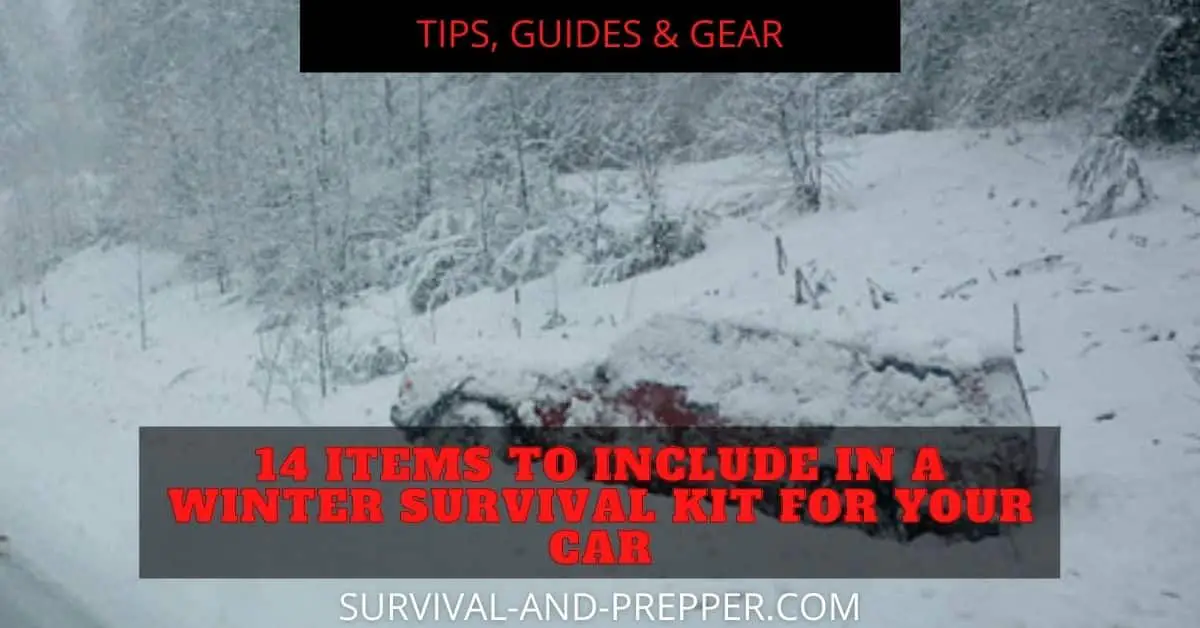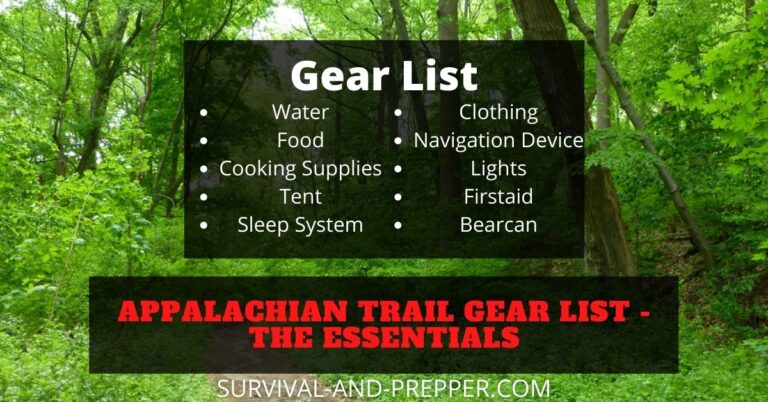14 Items to Include in a Winter Survival Kit for Your Car
Make a Winter Survival Kit and Don’t Rely on your Summer Supplies
It is likely that you already have some form of emergency equipment in your vehicle. However, I am going to point out some items you may not have considered. I’ll also stress the importance of cycling your kit at least twice a year. So let’s delve into the items that make up your winter survival kit for your car.
When it reaches a point in which you need your survival kit, you need it to work right then. This is where many survival kits fail. Often they are not inspected on a routine basis. When you need your roadside emergency kit you discover it is damaged or non working. By rotating your Winter Survival Kit and Summer Kit then you can ensure that they are properly inspected at least once every six months.
Since it is fairly common for you to be at least in the vicinity of your vehicle we are going to tailor this winter survival kit plan to that. This will allow us to add some items we might not normally carry in a survival kit. The winter car survival kit needs to be compact and easy to store.
With those steps in mind lets begin to discuss the items you should carry. They should enable you to get your vehicle back on the road, assist a stranger or in a worst case scenario prevent you from freezing or starving to death.
Keep in mind these items become even more critical if you face dangers such as heavy snow fall. Now to take a look at the items you should include in your winter car kit. Take a look how this woman walked 30 miles in the snow to get help for her family.
Vehicle Specific Items You Should Include in Your Winter Car Kit
These items are those which are specific to getting your vehicle back on the road. They will be too heavy to carry in most cases, but will be kept in a vehicle so that is not a major concern. We will get to those items needed for personal survival in case you have to abandon your vehicle later on in the article.
A Portable Air Compressor
Why is a roadside emergency kit with air compressor important? One of the most common issues that arise with a vehicle in any season is a flat tire. This could be from a slow air leak or a major puncture. Sometimes you prepare to swap the tire and discover that your spare is flat as well, this is the point that a portable air compressor would come in handy.
There are three common types that you could employ in this scenario. They can be battery powered, gas powered or powered by the 12 volt system in your vehicle. Each of these have some advantages and some disadvantages.
While they are able to provide far more air supply, I suggest you avoid the gas powered types, they are large, bulky and require a liquid fuel source.
The next option and the cheaper of the two options is one that is powered by your vehicle’s 12 volt power system. These tend to be lightweight and easy to store. They do rely on your vehicle’s power system though so make sure that you frequently test your 12 volt plugs to ensure that they work.
The last option is my preferred choice and that is a battery powered option. These generally have many additional features that will check off some of the other needs on this list as well. While that makes them more expensive, it allows you to wrap multiple features into a single item and save space. An example of this is the Stanley Fat Maxx (Amazon Link). It functions as an air compressor, jump box, back up light and USB charger.
Jumper Cables or Jump Box
The next most common auto trouble tends to be a dead battery. I have gone on several trips where I left my vehicle at an airport or cruise terminal only to return several days later and discover that my battery was dead and my vehicle would not start.
For years the main remedy in this case was jumper cables. However in more recent years the jump boxes have become more common and have dropped in price. The jump boxes have numerous advantages over standard cables. Either way, make sure you carry one of these two options.
It is surprising how many people do not have jumper cables and even worse than that it is possible that you may find yourself in some remote area with no one else around to provide a second battery to jump off of. This is the main reason why I suggest a Jump Box over standard jumper cables.
Another advantage of a jump box over standard jumper cables is the chance of connecting them improperly and damaging your vehicle or another is reduced. This is due to the fact that the majority of jump boxes are capable of detecting incorrect hookups and will not provide a charge if not connected properly.
Last jump boxes come with extra features which make them multipurpose. To bring up the Stanley Fatmax again it is capable of jumping off a vehicle without the need of a second vehicle. It also has the built in usb charger, light and air compressor.
Check out our article How to Jump Start Your Car to learn how to safely jump your vehicle.
Basic Tool Kit Including Tire Plugs and Fixaflat
If you have some basic mechanical knowledge there are numerous roadside fixes that can be handled with some basic tools. Make sure to include a set of pliers, adjustable wrench, vice grips, duct tape and screwdrivers.
A tire plug kit or fixaflat is also an awesome investment, if properly used you can often repair the tire at least temporarily without even having to remove it from the vehicle. Keep in mind both of these items work better warm, so be sure to store them in the passenger compartment under a seat or in the glove box.
By being able to quickly repair or at least temporarily repair your vehicle, you can hopefully get your vehicle back to civilization and avoid a costly tow or having to spend the night in terrible conditions.
A Led Flashlight
You should always keep a small flashlight in your vehicle as it can be used for changing a flat tire, signalling a passing motorist, examining the engine compartment of your vehicle, or just looking for an item you dropped under your seat.
In this area the choice is yours; however, LED versions are brighter and generally consume less power allowing them to last longer. Some newer models allow you to recharge them via USB cables and the use of a wall socket or 12 volt car plug similar to a cell phone.
My preferred choice is the Streamlight 88054. That is based on my preference for that brand and carrying a streamlight for more than a decade as an everyday carry. It was always dependable and I have only had to replace the battery once every five years or so. (That version was a Streamlight Stinger, I only recently got the Streamlight 88054.)
However, the Streamlight is a bit more expensive than some other models and you can find cheaper alternatives here on Amazon if you prefer.
Safety Absorbent or Kitty Litter
While this item may seem a bit confusing it has numerous benefits for your safety. Both Kitty Litter and Safety absorbent are gravel like absorbent material. This makes them great at providing traction on slippery surfaces.
If you find yourself stuck in the snow or ice you can liberally apply this around the front or rear of your tires and give your tires a chance to bite into the ice. Additionally you can use it as a snow melt to make working or standing around your vehicle safer for you in icy conditions.
Check out our article on 14 uses for Kitty Litter for more tips on how to use litter or safety absorbent.
Cell Phone and Charger
A cell phone could be the difference in Life or Death in the case of a serious car crash, becoming stranded in the ice or having a major vehicle malfunction in extreme weather. That being said, a cell phone cannot help you if the batteries are not charged. Make sure to keep your cell phone with you along with a method to charge it.
I hate to keep harping on it but this again is an area where the Stanley Fat Max can be of use. With it’s USB charging ports you can recharge your cell phone even if your car is completely dead and the battery drained.
Foldable or Camp Shovel
This can be left out if there is no chance of you encountering snow, however if snow is a possibility this could be a life saver. Being able to dig the compacted snow out from under the wheels or edge of the car will allow you to free up your vehicle and hopefully reach safety and warmth. These can often be found online (Amazon Link) or in military surplus stores.
I purchased a Coleman Folding Shovel with a pick for this. It is not the strongest option, but its price makes it a decent choice for digging out the snow. You can check it out on Amazon.
Snow Chains and a Tow Rope
Snow chains are a great option if you can use them. However, it is important to note that they will not work on some vehicles due to the design of the vehicle. Additionally installing them for the first time can be extremely difficult if you are not familiar with how they work.
If you have a four wheel drive or an all wheel drive you will likely not need to concern yourself with snow chains though they may still be worth looking into if you feel you will encounter extreme snow and ice.
Another option commonly employed in some Northern States is swapping out your tires in late fall for studded snow tires. This of course depends on the regulations in your state so you will have to check to see if they are available.
In the case of a tow rope, it may be that your vehicle is not capable of towing someone else, but it could prove useful in helping get your vehicle out of ditch if a good samaritan comes by.
The Items You Need for Personal Survival
These are items that would fall into what some call a get home bag. They should cover most of the dangers you are going to encounter, provide you ample assistance in surviving the conditions and allow you to reach home safely.
Due to the fact that you will likely be carrying these on your back they need to be light, durable and able to be kept dry.
First Aid Kit
A first aid kit is a given in any vehicle; however, in this case I put it in the get home bag. Because of this you need a kit that is able to cover a fairly wide range of injuries. Yet it needs to remain small and compact enough to fit into a backpack. A car wreck is not the only potential danger in which you could be injured on your trek home. Make sure not to skimp out here.
I prefer to put together my own kit based on my skill level. However if looking for a prepackaged solution you could check out this relatively inexpensive one from Amazon with over 17000 reviews.
A Blanket – No not the One From Your Bed
If you knew for a fact that you could remain in your vehicle then any blanket that you felt was capable of keeping you warm would be sufficient.
However, this kit is being put together with the premise that you could be forced from your vehicle and need to seek help on foot. Due to this we need a more durable and dependable option. A regular blanket would lose all of its benefit as soon as it became wet by either rain or snow.
This is where either a Gortex Sleeping bag or some form of Mylar Space or Survival Blanket come into play. Mylar blankets have a special foil like coating designed to reflect 90% of your body’s heat back on you. They are also water and windproof greatly increasing their ability to protect you from the elements.
My preferred choice here is the Tact Bivvy 2.0 from survival frog. Weighing just 7 ounces and being 7 feet long by 3 feet wide it can accommodate most full sized adults with ease. In addition to that it comes with a length of flammable paracord to assist with building a fire and a 120 decibel emergency whistle to help signal for help.
Heavier Clothing including Hat and Gloves
In most cases when you are out and about it is done with the knowledge that you are only going to be out in the cold for a short period of time. Because of this you may dress in lighter clothing than you would if you knew you were going to be out in the cold for hours or even possibly days.
Make sure to add several garments that you can use to layer your clothing. For instance you may want to include some long john or underarmor type under clothes for the first layer. You can enter your vehicle before the heat has dissipated and put those on before venturing out if need be.
Next will be your normal clothing. Then you want to add either a lightweight jacket or a heavier coat depending on your normal wear. For example I wear a heavy oversize Carhart Jacket as my primary coat. It is already very durable and makes an excellent outer jacket. Due to that being my normal wear I included a lighter weight fleece jacket. I can wear it over my regular clothes and under the Carhart in extreme weather. If you normally wore a lighter jacket then you want to add a heavy coat to your Winter Survival Kit.
Keep in mind that you are likely to be dealing with a snowy environment. This is important as it affects what the best color options are. I suggest that you have brightly colored but contrasting clothes. Things such as bright blues, reds or even hunter orange. The goal in this type of situation after all is to find help and make it home safely.
Food and Water
In the case of Food and Water you want to make sure that the packages allow you to easily carry it and divide it up. The items need to be packaged in individual servings as well to ensure freshness. You should have about five days worth of food and water stored in your vehicle. This can be in any form you want. You will only be taking about three days worth with you if you have to leave your vehicle and travel on foot.
The extra food and water are so that you begin your trek already hydrated and fed. This allows you to carry less and prolong the point at which you access your rations. So once you decide to leave your vehicle make sure to eat some of the food. Also drink at least two twenty ounce bottles of water. Again this allows you to start your trek with less weight and water already in your system.
Fire Starter
Obviously if you end up being stranded in a winter environment you are going to need a source of heat. Most survivalists say that you should have at least three methods to create a fire. I am going to suggest some all weather matches, a lighter and some flares.
I know the more common answers are things like strike rod etc and that is true in the case of a long term survival scenario. However, for this kit it is intended as a temporary fix to ensure you make it home. The best way to do this is for the methods included to be easy and quick to use. In the extreme cold you do not have time to be struggling to start a fire.
Matches and lighters are pretty obvious when it comes to starting a fire. At the same time you may not be aware of flares. You can use either full sized auto flares or smaller flares. You can find them in Ultra Compact 3 minutes, Medium Sized 15 minute and Larger 30 minute burn intervals. I suggest that you have some of the thirty minute flares stored in your vehicle but that you consider the smaller flares for your survival pack.
Simply gather some wood, dry is preferred. Though with the extended burn times of a 15 or 30 minute flare it is likely you can get some damp wood ignited. Build a fire lay and then light a flare. Allow it to feed the wood and ensure it is well lit.
Road Map
While it might seem strange that I have included this in the personal survival kit instead of the vehicle there is a reason for that. In order to increase your chances of being found you want to remain on the roadways. By having a road map navigating to the nearest town will be far easier with a map to guide you.
If the distance to the nearest town is quite far then seek out the largest roadway you can. These larger roads have several advantages. They have a higher volume of traffic increasing the chance you can find help, they also tend to be easier to travel along. Often major roadways cut through hills and are raised in low areas. This allows a much flatter path of travel than some smaller roads may present.
Now Take Action and Put Together The Best Car Emergency Kit
Now that we have covered the basics of a roadside emergency kit and a personal survival kit, you put these together to form your own car emergency kit. While it does not matter if you choose to call it a roadside emergency kit or a car survival kit either way it is important that you make sure you have one.
Doing so could be the deciding factor in you making it home in the case of a vehicle accident or break down in a remote location.









